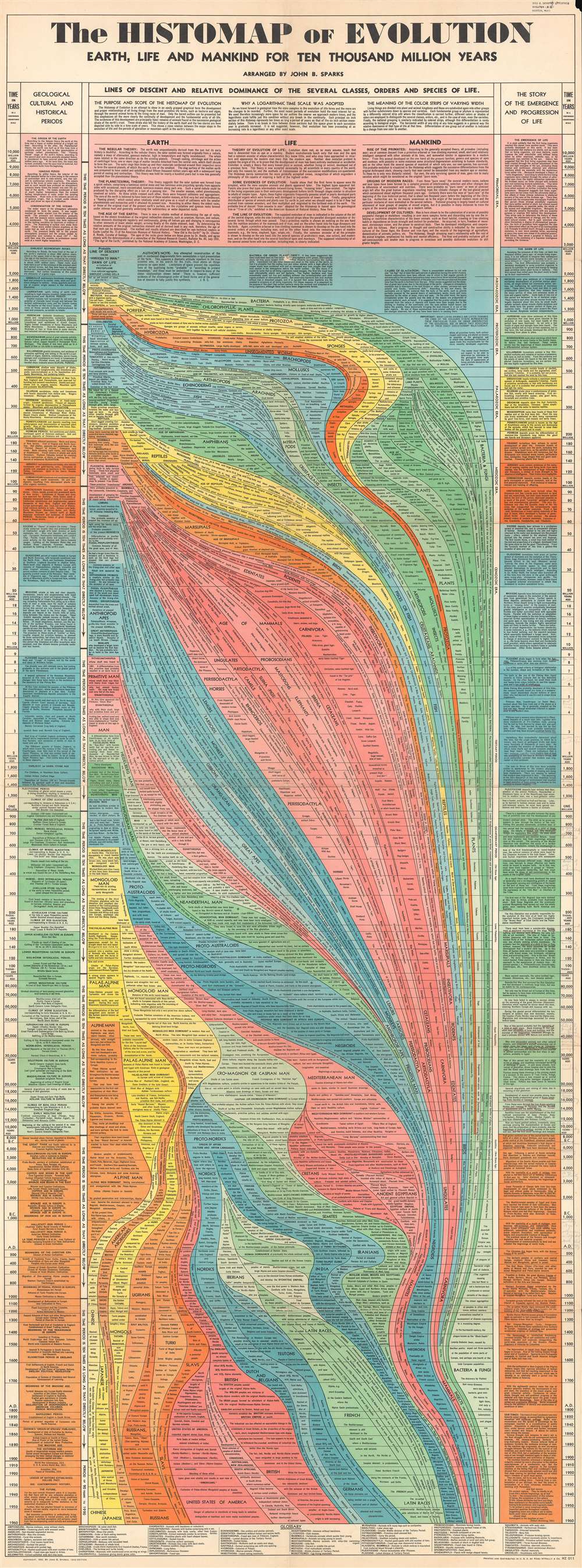
This item below is out of stock, but another example (left) is available. To view the available item, click "Details."
Details
1949 John Sparks Infographic Chart or Histomap of Evolution
1949 (dated) $875.00
1942 John Sparks Infographic Chart or Histomap of Evolution
HistomapEvolution-sparks-1942
Title
1942 (dated) 58 x 21.5 in (147.32 x 54.61 cm)
Description
A Short History of the Chart
Overflowing with information, Sparks spent fourteen years working on the Histomap of Evolution. A bacteriologist and chemical engineer, an interview with Sparks appeared in the Plainfield, New Jersey Courier-News on October 13, 1932, shortly after the first edition of the Histomap. Sparks originally did not want to have the Histomap published, although why it ended up in publication is not made clear. Per the article, the Histomap gave renewed fervor to the debate over evolution, a topic known for its controversy (see the Scopes Monkey Trial).Sparks' Own Comments About the Chart
Sparks is quoted at length in the article in the Courier-News. We believe that his language sheds light on the world in which this chart was created and may have some relevance today. Evolution has not lost any of its controversial in the last eighty-seven years, and Sparks' comments ring true even now.I regret to hear that the Histomap has aroused the evolution controversy again, as the present conflict is not between science and fundamentalism, but between behaviorism and spirituality. Modern mystics and other spiritually minded men and women accept evolution but do not deny God or Christ, and these spiritual forces must combine against the growth of materialistic behaviorism as represented by Dr. John B. Watson and Charles Dorsey.These same issues have again, it seems, become culturally divisive.
Fundamentalism, instead of being the bulwark of religion, is its most vulnerable spot. It is outmoded and inconsistent with modern thought, a very 'heel of Achilles' which we must dispose of before we can establish a firm front in this new conflict. Evolution applies to mental and spiritual growth as much as to the development of man as an organism.
Publication History and Census
This chart was published in three editions in 1932, 1942, and 1949, respectively. The current example represents the 1942 edition. Four examples of the 1942 edition are cataloged in the OCLC as being part of the collection at Duke University, Pennsylvania State University, the IRIS Consortium in Florence, and the Biblioteca Berenson at the Harvard University Center for Italian Renaissance Studies in Florence. There is also an example at the David Rumsey Collection. It appears from time to time on the market.CartographerS
John B. Sparks (1886 - December 22, 1949) was a chemical engineer, bacteriologist, and historian. Born in England, at some point in his life Sparks immigrated to the United States. He developed a fascination with culture, history, and the philosophies of other civilizations from a young age, which led him to create a series of three 'histomaps' concerning history, evolution, and religion. At the time of his death, Sparks was a director of Nestle's Milk Products Inc. in New York City. He married Dorothy C. Sparks with whom he had three children, one son and two daughters. More by this mapmaker...
Rand, McNally and Co. (fl. 1856 - present) is an American publisher of maps, atlases and globes. The company was founded in 1856 when William H. Rand, a native of Quincy, Massachusetts, opened a print shop in Chicago. Rand hired the recent Irish immigrant Andrew McNally to assist in the shop giving him a wage of 9 USD per week. The duo landed several important contracts, including the Tribune's (later renamed the Chicago Tribune) printing operation. In 1872, Rand McNally produced its first map, a railroad guide, using a new cost effective printing technique known as wax process engraving. As Chicago developed as a railway hub, the Rand firm, now incorporated as Rand McNally, began producing a wide array of railroad maps and guides. Over time, the firm expanded into atlases, globes, educational material, and general literature. By embracing the wax engraving process, Rand McNally was able to dominate the map and atlas market, pushing more traditional American lithographic publishers like Colton, Johnson, and Mitchell out of business. Eventually Rand McNally opened an annex office in New York City headed by Caleb S. Hammond, whose name is today synonymous with maps and atlases, and who later started his own map company, C. S. Hammond & Co. Both firms remain in business. Learn More...

